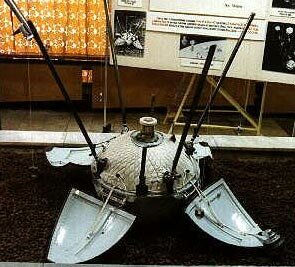

Оглавление РефератыThe Moon2.3) Luna OrbiterLuna 10 (E-6LS)
The E-6LS was a radio-equipped version of the E-6 used to test tracking and communications networks for the Soviet manned lunar program. Otherwise the spacecraft instrumentation was similar to that of the E-6LF and provided data for studies of the interaction of the earth and lunar masses, the lunar gravitational field, the propagation and stability of radio communications to the spacecraft at different orbital positions, solar charged particles and cosmic rays, and the motion of the Moon. 17 May 1967 Cosmos 159 Program: Lunar L1. Mass: 4,490 kg. Perigee: 350 km. Apogee: 60,637 km. Inclination: 51.6 deg. The E-6LS was a radio-equipped version of the E-6 used to test tracking and communications networks for the Soviet manned lunar program. The payload entered the desired orbit as Kosmos-159. Failed launch of an E-6LS radio-equipped version of the E-6 used to test tracking and communications networks for the Soviet manned lunar program. Suggestions for the abnormal consumption included the seizing up of a pintle valve for controlling fuel supply into the regulator or the seizing up of the fuel inlet control. The upper stages broke up in the atmosphere. Lunar Orbiter; studied lunar gravitational field, Earth-Moon gravitational relationship, and conducted further scientific experiments in circumlunar space. Not revealed until years later was that the E-6LS was primarily intended to test tracking and communications networks for the Soviet manned lunar program. The Luna 14 spacecraft entered a 140 x 870 km x 42 degree lunar orbit on April 10, 1966. The spacecraft instrumentation was similar to that of Luna 10 and provided data for studies of the interaction of the earth and lunar masses, the lunar gravitational field, the propagation and stability of radio communications to the spacecraft at different orbital positions, solar charged particles and cosmic rays, and the motion of the Moon. This flight was the final flight of the second generation of the Luna series. 1966 Luna 10 Spacecraft: Luna E-6S. Mass: 1,597 kg. Lunar Orbit (Selenocentric). Development of system to permit the creation of an artificial lunar satellite for the investigation of circumlunar space; development of onboard systems for putting a station into a selenocentric (circumlunar) orbit. Orbit: Lunar Orbiter. The Luna 10 spacecraft was launched towards the Moon from an Earth orbiting platform. The spacecraft entered lunar orbit 3 50 x 1017 km, inclination 71.9 deg to plane of the lunar equator. on April 4, 1966. Scientific instruments included a gamma-ray spectrometer for energies between 0.3--3 MeV, a triaxial magnetometer, a meteorite detector, instruments for solar-plasma studies, and devices for measuring infrared emissions from the Moon and radiation conditions of the lunar environment. Gravitational studies were also conducted. The spacecraft played back to Earth the `Internationale' during the Twenty-third Congress of the Communist Party of the Soviet Union. Luna 10 was battery powered and operated for 460 lunar orbits and 219 active data transmissions before radio signals were discontinued on May 30, 1966. 1966 Luna 11 Spacecraft: Luna E-6LF. Mass: 1,638 kg. Automatic station Luna 11. Further development of artificial lunar satellite systems and conduct of scientific experiments in circumlunar space. Lunar orbit 160 km x 1200 km x 27 degrees. Luna 11 was launched towards the Moon from an earth-orbiting platform and entered lunar orbit on August 28, 1966. The objectives of the mission included the study of: (1) lunar gamma- and X-ray emissions in order to determine the Moon's chemical composition; (2) lunar gravitational anomalies; (3) the concentration of meteorite streams near the Moon; and, (4) the intensity of hard corpuscular radiation near the Moon. A total of 137 radio transmissions and 277 orbits of the Moon were completed before the batteries failed on October 1, 1966. 1966 Luna 12 Spacecraft: Luna E-6LF. Mass: 1,620 kg. Lunar Orbiter, further development of artificial lunar satellite systems and conduct of scientific experiments in circumlunar space. Luna 12 was launched towards the Moon from an earth-orbiting platform and achieved a lunar orbit of of 100 km x 1740 km on October 25, 1966. The spacecraft was equipped with a television system that obtained and transmitted photographs of the lunar surface. The photographs contained 1100 scan lines with a maximum resolution of 14.9--19.8 m. Pictures of the lunar surface were returned on October 27, 1966. The number of photographs is not known. Radio transmissions from Luna 12 ceased on January 19, 1967, after 602 lunar orbits and 302 radio transmissions. |
|
Конкурс рефератов: Тема: The Moon Автор : БАННЕРЫ: |

